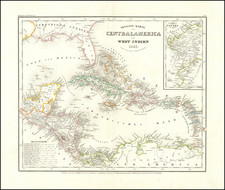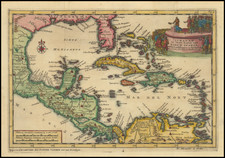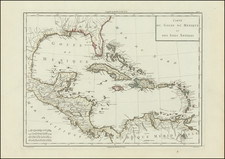The second earliest printed map of Barbados, preceded only by Ligon's map. Ogilby never visited the island, but did not use the earlier map of Ligon as his source, which remains unknown. It was one of the four maps added by Ogilby to the Montanus work, America, in his English Translation. Within the map, Ogilby illustrates local people and crops. Spelling are perhaps more faithful to their original Indian pronunciations. Many place-names are plotted along the coast, but there is no interior data. The vignette of a dark-skinned laborer reflects the British use of both Indian and Black slaves on the island at this time. There are several vignettes of different trees and plants on the map (a Pine Aple, Suger Cane, Indian Corne, etc.), various settlements named for the plantation owners, etc/ Fine wide margined example in nice color.
John Ogilby (1600-1676) was an English geographer and publisher, one of the most prominent of the seventeenth century. Little is known of his early life but by 1619 he was apprenticed to John Draper, a dancing-master in London. He worked as a dancing-master, courtier, and theater owner form 1620-1641. From 1649 he worked as a poet, translator, and publisher of classical texts. It is only in the last decade of his life that he entered into geography.
In 1649, Ogilby published his first translation, of Virgil, and continued to put out translations in the 1650s and 1660s. In March 1661 he was reconfirmed as master of revels in Ireland and appointed master of the king’s imprimeries, or king’s printer. From 1662 to 1665 he was in Ireland, where he most likely met Robert Boyle. He returned to London only to lose much of his printing stock in the Great Fire of 1666. Post-fire, he became assistant surveyor to the city, where he met Robert Hooke and Christopher Wren.
In 1669, Ogilby published Embassy to China. At the same time, he planned to release atlases that would cover the entire world. These atlases would be funded via subscriptions, advertisements, and lotteries—all common practice at the time, especially for expensive multi-volume works. He released Africa and Atlas Japannensis in 1670, America in 1671 and Atlas Chinensis in 1671, and Asia in 1673. Ogilby compiled the works based on materials produced by others and they reflect a growing interest in the wider world within England.
In 1671, while producing the atlases, Ogilby secured another royal title, that of his Majesty’s cosmographer. He used this title when publishing Britannia in 1675, his best-known work. The Britannia is best described as a road atlas; it shows 2519 miles of road in 100 strip maps. This technique would be widely adopted in the subsequent century. His method of measuring with a waywiser, a large wheel, also helped to standardize the distance of the English mile at 1760 yards. The Britannia was a major achievement in early English cartography and was republished in 1698, 1719, and 1720.










![Map of Mexico, Central America, and the West Indies [Insets of Bermuda, Sandwich Islands, Jamaica and Panama Railroad]](https://storage.googleapis.com/raremaps/img/small/78369.jpg)


![[Rare Blaeu West Indische Pascaert Wall Map Section] Insulae Americanae in Oceano Septentrionali, cum terris adjacentibus](https://storage.googleapis.com/raremaps/img/small/75672.jpg)
![Pas kaart Vande Zuyd kust van Cuba en Van Geheel Yamaica en andre bygeleegen plaatsen Door Vooght Geometra . . . [includes Cayman Islands]](https://storage.googleapis.com/raremaps/img/small/52393.jpg)